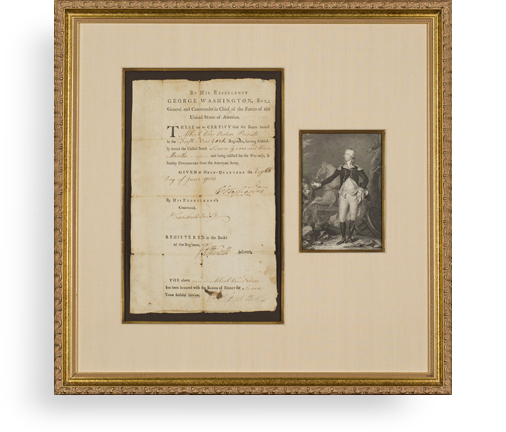With John Wilkes Booth Still on the Loose and Lincoln’s Body in the Capitol Rotunda, New President Andrew Johnson Rewards a Soldier for Heroism at the Battle of the Wilderness


He issues a promotion for "gallant conduct at the Battle of the Wilderness"
- Currency:
- USD
- GBP
- JPY
- EUR
- CNY
Documents signed in the first few days after Lincoln’s assassination are very uncommon, this being by far the earliest we have seen
The Battle of the Wilderness was fought on May 5–7, 1864, during the Civil War. It was the first battle of Lieut. Gen. Ulysses S. Grant’s 1864 Virginia Overland Campaign...
Documents signed in the first few days after Lincoln’s assassination are very uncommon, this being by far the earliest we have seen
The Battle of the Wilderness was fought on May 5–7, 1864, during the Civil War. It was the first battle of Lieut. Gen. Ulysses S. Grant’s 1864 Virginia Overland Campaign against Gen. Robert E. Lee and the Confederate Army of Northern Virginia. The fighting occurred in a wooded area near Locust Grove, Virginia, about 20 miles west of Fredericksburg. Both armies suffered heavy casualties, nearly 29,000 in total, a harbinger of a war of attrition by Grant against Lee’s army and, eventually, against the Confederate capital, Richmond, Virginia.
At 7:22 a.m. on April 15, President Lincoln breathed his last. Attendees smoothed the contracted muscles of Lincoln’s features, placed two coins over his eyes, and pulled a sheet up over his face. Famously, Secretary of War Stanton saluted the fallen President and uttered, “Now, he belongs to the ages.” Stanton further eulogized Lincoln with the apt observation, “There lies the most perfect ruler of men the world has ever seen.”
Lincoln’s public funeral service occurred on April 19 and the body lay in the Capitol Rotunda on April 20. At the same time, the government was printing wanted notices for the capture of the assassination conspirators, who remained at large.
On May 6, 1864, George Clendenin, Jr. was seriously wounded in the Wilderness but refused to leave the field, continuing to fight.
Document signed, April 20, 1865, signed by Johnson as president and Secretary of War Edwin M. Stanton, just 5 days after the death of President Lincoln, the same day Lincoln’s body lay in the Capitol Rotunda, appointing George Clendenin, Jr. a Major for “gallant conduct in the Battle of the Wilderness.”
Documents signed during the immediate post-assassination are very uncommon, this being our earliest ever.

Frame, Display, Preserve
Each frame is custom constructed, using only proper museum archival materials. This includes:The finest frames, tailored to match the document you have chosen. These can period style, antiqued, gilded, wood, etc. Fabric mats, including silk and satin, as well as museum mat board with hand painted bevels. Attachment of the document to the matting to ensure its protection. This "hinging" is done according to archival standards. Protective "glass," or Tru Vue Optium Acrylic glazing, which is shatter resistant, 99% UV protective, and anti-reflective. You benefit from our decades of experience in designing and creating beautiful, compelling, and protective framed historical documents.
Learn more about our Framing Services










































































































